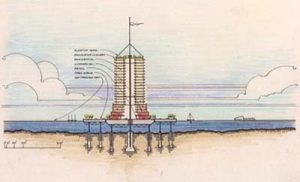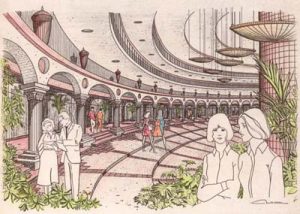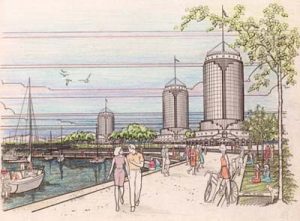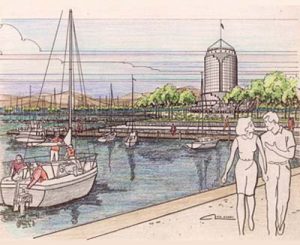Other Work – China Bay, San Francisco, CA
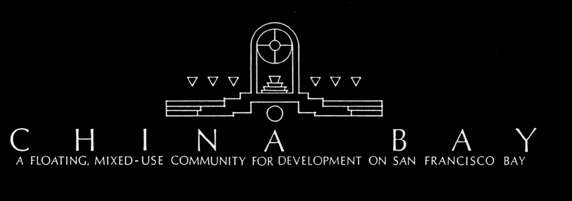
The purpose of this concept is neither to promote nor discourage development of this type but, rather to provide a glimpse into the not too distant future when practically all of San Francisco’s real estate has been utilized and development pressures are strong.
All of the designs, concepts and renderings were conceived, developed and financed solely by Michael Karby, without the aid of any client or special interest group.
 Vehicular and pedestrian access to China Bay is provided at Pier 40 along the Embarcadero, south of the Bay Bridge. Pier 40 is just north of the San Francisco Redevelopment Agency’s South Beach Harbor and serves as the land based focal point to the community. A community owned, multi-level parking garage is provided within close proximity to the pier.
Vehicular and pedestrian access to China Bay is provided at Pier 40 along the Embarcadero, south of the Bay Bridge. Pier 40 is just north of the San Francisco Redevelopment Agency’s South Beach Harbor and serves as the land based focal point to the community. A community owned, multi-level parking garage is provided within close proximity to the pier.
The experience of entering China Bay is intended to be one of anticipation and adventure, of boarding a ship bound for some exotic port. Nautical themes and the abundant use of fabric and sailcloth are designed to add to the experience.
The visual impact of China Bay, though substantial, is not overwhelming. By virtue of its location some half-mile from shore, the tallest tower presents a vertical visual arc of about 8 degrees when viewed from the closest point along the Embarcadero. This contrasts with a vertical visual arc of 85 to 90 degrees for a pedestrian in the financial district bounded by its skyscrapers. Given the delicacy of the ecosystem and the physiological rigors of the study site, China Bay employs a pedestrian-oriented circulation system in which any part of the community can be reached within 4 to 5 minutes walking time, or 2 to 3 minutes by bicycle.
The ground level galleria at the core of each tower is enclosed, landscaped and naturally lighted to the maximum extent possible. Enclosed glass pedestrian tubes for use in inclement weather connect each tower. Support services for the marinas are housed in a series of Teflon coated fiberglass fabric structures – tension supported – to induce a natural ambience and to reduce the weight of the floating structures.
Residents may enjoy the natural environment whenever they choose. A loop trail system between all towers is accessible only to pedestrians, bicycles and electric trams. Roads will be provided only to the extent necessary for the adequate provision of essential services, supply, delivery, maintenance, waste collection etc.
Rincon, the northern most tower at China Bay, provides parking at the lower decks of its open space structure and serves as the vehicular end link with the Embarcadero to the southwest. A four lane bridge with isolated pedestrian/bicycle lanes, landscaping, water fountains and seating is provided between the refurbished pier — which acts as a gateway to the project — and Rincon, the administrative, museum and commercial tower. The names of the towers correspond to the names of six of San Francisco’s hills: Rincon – 150′ ; Potrero – 330′ ; Bernal – 330′ ; Parnassus – 405′ ; Anza – 255′ and Cathedral – 210′. The height of each tower approximates the height of the hill it is named for.
Each of the six five-hundred foot diameter open space platforms is essentially a shallow draft structure restricted laterally by subsurface caisson-supported columns that permit only vertical (or tidal) movement. Rigidity is imparted to the platform by the use of exposed subsurface horizontal trusses extending radially from the core of the structure. Each of the towers displace between 17,000 and 26,000 tons. Total hydraulic displacement of China Bay is 123,824.5 tons.
Each of the six two-hundred-twenty foot diameter towers has, at its core, a full height reinforced concrete shaft that contains mechanical, electrical and plumbing equipment and provides support for four exposed elevators. A steel frame with metal pan deck and light weight concrete comprises the basic structural system of each of the towers. The towers displace an amount of sea water equivalent to their combined live and dead loads and, although structurally tied to the open space platforms, slowly rotate in a clockwise direction to provide all inhabitants a 360 degree view of the bay area.The retail section of China Bay is located on the first two floors of four of the six towers with three floors of retail at Parnassus. Rincon, the northernmost tower has 60,318 sq. ft. of museum, public information and gallery space on its first two floors. The combined retail area of the other five towers equals 322,010 square feet. Ingress to the retail spaces (as well as all other spaces within the towers) is provided by four double entry and vestibule chambers at each tower. Two of these are major entries while the other two are secondary in nature. These secondary entries also provide access to restrooms and emergency stairwells. Exposed elevators are located at the central shaft and connect to the second floor retail space with skyways.
The retail areas (like all other spaces within the towers) are circular in plan and lie at the perimeter of the structure facing the interior. A delivery corridor circles the retail along its exterior face and also serves as access to small outwardly facing business concerns such as sidewalk cafes and specialty shops. All six towers at China Bay contain commercial space. Rincon has six commercial floors and Parnassus has four, while Potrero, Bernal, Anza and Cathedral each have two to three floors dedicated to commercial space. The total area reserved for commercial uses at China Bay equals 432,272 square feet. Like the retail and residential spaces, the commercial floors are circular in plan and face the interior core. Openable windows are provided at the exterior perimeter of the space and access is from an interior mezzanine or balcony that circles the space on the interior. Skyways connect the mezzanine with the elevators at the central shaft. Emergency stairwells and restrooms are located at corridors opposite the skyways. To accommodate future modification of plan, none of the internal partitions have load bearing capabilities. Ceilings and floors are panelized with a hollow space provided behind each to allow for ease of access to computer and communication equipment. A satellite communication system is provided for the entire project as well as a cellular phone system for mobile voice access to China Bay.All floors above the commercial spaces and below the roof restaurant-public deck are dedicated to residential uses. Rincon is the only tower with no residential space. The total residential area at China Bay equals 583,074 square feet. Assuming an average unit size of 1,000 square feet (actual unit sizes will vary) and an average density of 2.57 persons per unit, China Bay is designed to support about 1,500 permanent residents in approximately 583 units.
Individual unit design may be done prior to sale or lease, or may be done by the buyer’s own architect or interior designer at the designer at the time of purchase. As with the commercial space, none of the interior partitions are load bearing, in order to provide maximum flexibility. All units have unobstructed views of the bay and actually sweep 360 degrees because of the rotation of the towers. More units could conceivably be accommodated because the extra vertical space allotted to each unit does restrict the number of floors. As designed, all units have approximately fourteen foot ceilings to provide a sense of openness in even the smallest of units. Such a high ceiling allows for the introduction of lofts and secondary spaces to all units. There are an average of eight to ten residential units per floor with a small laundry facility and central trash depository also located on each floor. Space for a combined resident and office employee child care facility is provided on one of the commercial floors of each tower. The housing provided by this project (as well as all other spaces within China Bay) is new and original and does not require the demolition, displacement or conversion of any of San Francisco’s existing housing stock.There are actually three marinas at China Bay: two public and one private. The two combined public marinas accommodate about 500 pleasure craft ranging in size from 20 to 50 feet. Full fueling and repair facilities are provided at each marina with first option on availability of slips offered to residents and commercial tenants. They are designated as “Marina East” and “Marina West”.These two harbors provide much needed space for San Francisco’s overcrowded boating population and may provide space for for commercial fishing enterprises as well. When added to the +/- 670 berths at the San Francisco Redevelopment Agency’s South Beach Harbor, the China Basin area will support some 1100 to 1200 additional pleasure and fishing craft.
The smaller, private marina located to the east of Rincon is designated specifically for use by service, fire and life safety vessels. By locating a fire boat station directly adjacent to China Bay, response time is greatly reduced, insurance rates are reduced and overall safety for all residents and tenants is greatly enhanced.
All marinas open to the south with breakwaters on the north and remaining sides. This is to protect all vessels from winds and rough seas coming in from the north. There are two types of open space at China Bay: public exterior space and semi-public interior space.The public exterior space of each tower is 158,336 square feet in size or slightly greater than three and one half acres. The total exterior space of all six towers equals 950,016 square feet or nearly twenty-two acres. This space is heavily planted with lawns, shrubbery, flowers and a variety of trees, including a coniferous windbreak at key points along the perimeter. Perimeter paths encircle the open spaces and are connected to the towers with a network of meandering foot and bicycle trails. Benches, water fountains and group display areas are liberally provided. The landscaping is designed to maximize view corridors in all directions. Some degree of formalism is evident in the exterior spaces but an attempt has been made to humanize the scale of the project by providing niches and private areas where possible.
The second type of open area is the semi-public interior space. This is located on the first floor of the retail area. This space, or gallery, is one hundred feet in diameter and has the central elevator shaft at its core. Fountains and canvas are used throughout the gallery to accentuate the nautical theme of China Bay. The gallery, though not specifically an “outside open space”, is a place of great social interaction, serving as an area for art exhibits, cafes, craft displays and people watching. Each gallery is intended to reflect the character of the residents and businesses in that tower. Each gallery is 7,854 square feet in size. Total gallery space equals 47,124 square feet.



